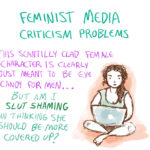Tumbling over the past year and a half has made me see the problems of gender roles that exist in media, but sometimes it gets to the point where I over analyze every single piece of television or film that I come across. (However this in no way means that I think feminist media criticism is wrong, or should be avoided!) Mostly I just over think everything.
I’ve thought about this a lot and I think the answer is MORE, and MORE DIVERSE female characters.
We’re used to having one or two female characters in a cast of mostly men, and hold them to a higher standard because of that. So all of feminism is resting on the shoulders of one female character – and that DOESN’T WORK. Because there isn’t one right way to be a woman.
If casts had more diversity of gender, we could have warrior women and non-warrior women, sexual women and non-sexual women, feminine and non-feminine, and mixtures of all of the above…all are completely legitimate ways to be a woman.
We’re used to seeing a lot of hypersexualized, scantily clad, one-dimensional stereotypes of women without stories or motives of their own. We respond by asking for characters that AREN’T THAT, but we may end up pushing too far in the opposite direction, and demonize traits like sexuality, conventional attractiveness, and traditional femininity as “sexist.” That’s why the most popular female characters are the ones that are most similar to male heroes – the Arya Starks – emotionally distant, unattached, solve their problems with violence, not remotely sexual. That’s fine too of course. I love Arya. It’s just not…the only way to be.
My life everyday… 🙁
Trying to keep balanced feminist perspective of media can sometimes lead to feeling paranoid… about having valid concerns! How ironic.
gingerhaze’s response is probably the only true answer to this: we need rich and diverse female representation in media.
The problem lies not with us seeing specific fictional women as problematic, the problem is that there are so few women in fiction that they end up representing the whole gender.
Thus, for example, being critical of one female character, if there are just three available, becomes a statement aimed not only at one person, but at women as a whole, as she’ll be inevitably compared to the other two.


